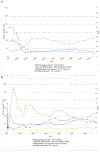The roles of homocysteinemia and methylmalonic acidemia in kidney injury in atypical hemolytic uremic syndrome caused by cobalamin C deficiency
- PMID: 34854955
- PMCID: PMC9160205
- DOI: 10.1007/s00467-021-05372-6
The roles of homocysteinemia and methylmalonic acidemia in kidney injury in atypical hemolytic uremic syndrome caused by cobalamin C deficiency
Abstract
Background: Cobalamin C (cblC), a vitamin B12 processing protein, plays a crucial role in metabolism for the conversion of homocysteine to methionine and methylmalonyl-CoA to succinyl-CoA. CblC deficiency, an inborn error of cobalamin processing, is a rare cause of atypical hemolytic-uremic syndrome (aHUS) and results in hyperhomocysteinemia and methylmalonic aciduria. Both substances are thought to contribute to thrombotic microangiopathy (TMA) in cblC deficiency patients. However, the roles of homocysteine and methylmalonic acid (MMA) in these patients remain unclear. We want to shed more light on the contributions of homocysteine and MMA levels as contributing factors for thrombotic microangiopathy (TMA)/aHUS by a follow-up of a cblC deficiency patient over 6 years.
Case diagnosis: A 27-day-old Hispanic female presented with abnormal C3-carnitine on her newborn screen, poor feeding, decreased activity, and oligouria. She was diagnosed with cblC deficiency after laboratory results revealed elevated serum homocysteine, and serum MMA along with genetic testing showing a homozygous pathogenic frameshift variant in MMACHC. The patient developed aHUS and acute kidney injury (AKI), which resolved after appropriate therapy. Over 6 years, she continued to have normal kidney function with no thrombocytopenia despite persistently elevated homocysteine and MMA levels.
Conclusion: We question the roles of homocysteine and MMA as causative of aHUS/TMA in cblC deficiency as they remained elevated during follow-up but did not result in aHUS/TMA or AKI. Hyperhomocysteinemia and/or MMA caused by other metabolic diseases do not result in aHUS/TMA or AKI. This suggests that other nephrotoxic factors may trigger aHUS/TMA in cblC patients.
Keywords: Acute kidney injury; Cobalamin C; Thrombotic microangiopathy; aHUS.
© 2021. The Author(s), under exclusive licence to International Pediatric Nephrology Association.
Figures

Similar articles
-
Atypical hemolytic uremic syndrome induced by CblC subtype of methylmalonic academia: A case report and literature review.Medicine (Baltimore). 2017 Oct;96(43):e8284. doi: 10.1097/MD.0000000000008284. Medicine (Baltimore). 2017. PMID: 29068997 Free PMC article. Review.
-
Thrombotic microangiopathy caused by methionine synthase deficiency: diagnosis and treatment pitfalls.Pediatr Nephrol. 2017 Jun;32(6):1089-1092. doi: 10.1007/s00467-017-3615-6. Epub 2017 Feb 16. Pediatr Nephrol. 2017. PMID: 28210839
-
Adult-onset combined methylmalonic acidemia and hyperhomocysteinemia, cblC type with aortic dissection and acute kidney injury: a case report.BMC Nephrol. 2024 Jan 4;25(1):13. doi: 10.1186/s12882-023-03414-9. BMC Nephrol. 2024. PMID: 38178022 Free PMC article.
-
Late-onset renal TMA and tubular injury in cobalamin C disease: a report of three cases and literature review.BMC Nephrol. 2024 Oct 10;25(1):340. doi: 10.1186/s12882-024-03774-w. BMC Nephrol. 2024. PMID: 39390411 Free PMC article. Review.
-
Hemolytic uremic syndrome with dual caution in an infant: cobalamin C defect and complement dysregulation successfully treated with eculizumab.Pediatr Nephrol. 2018 Jun;33(6):1093-1096. doi: 10.1007/s00467-018-3941-3. Epub 2018 Mar 20. Pediatr Nephrol. 2018. PMID: 29558000
Cited by
-
Toxic Metabolites and Inborn Errors of Amino Acid Metabolism: What One Informs about the Other.Metabolites. 2022 Jun 8;12(6):527. doi: 10.3390/metabo12060527. Metabolites. 2022. PMID: 35736461 Free PMC article. Review.
-
Case presentation: a severe case of cobalamin c deficiency presenting with nephrotic syndrome, malignant hypertension and hemolytic anemia.BMC Nephrol. 2024 Jul 8;25(1):217. doi: 10.1186/s12882-024-03656-1. BMC Nephrol. 2024. PMID: 38977946 Free PMC article.
-
Using Bayesian networks with Tabu-search algorithm to explore risk factors for hyperhomocysteinemia.Sci Rep. 2023 Jan 28;13(1):1610. doi: 10.1038/s41598-023-28123-z. Sci Rep. 2023. PMID: 36709366 Free PMC article.
References
Publication types
MeSH terms
Substances
Supplementary concepts
Grants and funding
LinkOut - more resources
Full Text Sources
Medical
Miscellaneous

